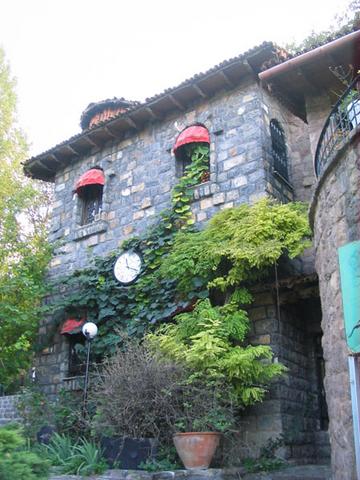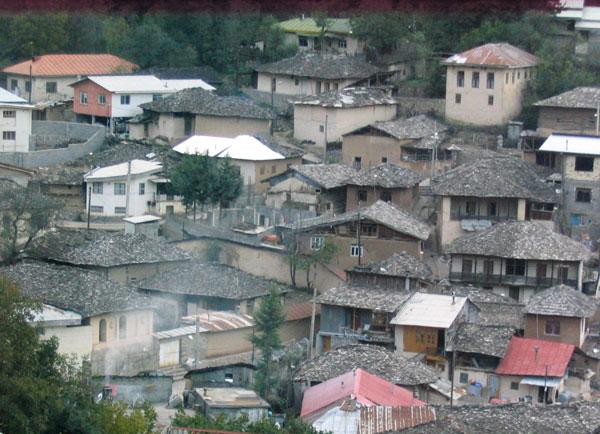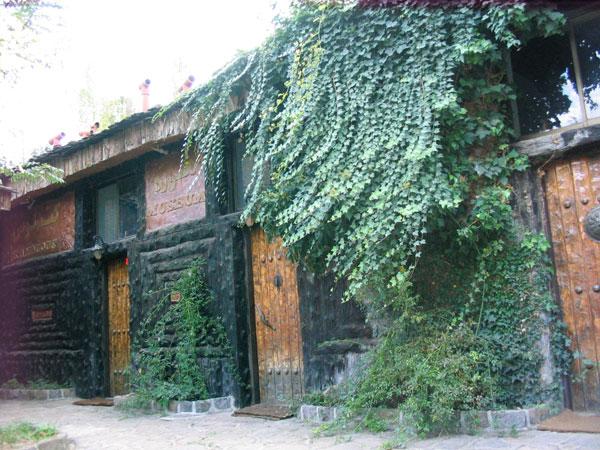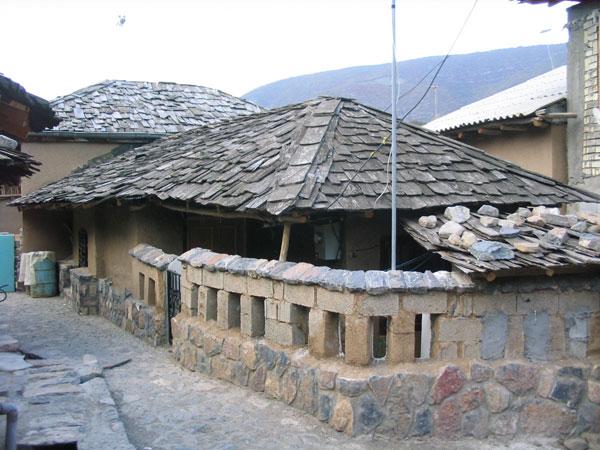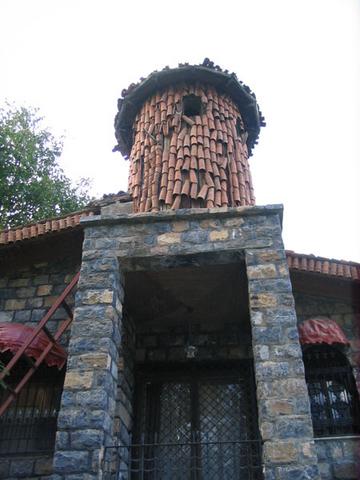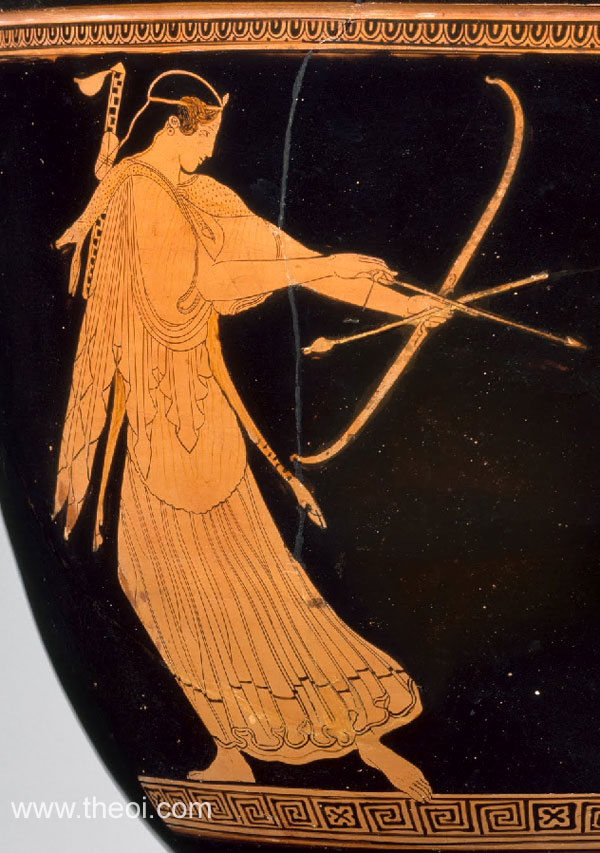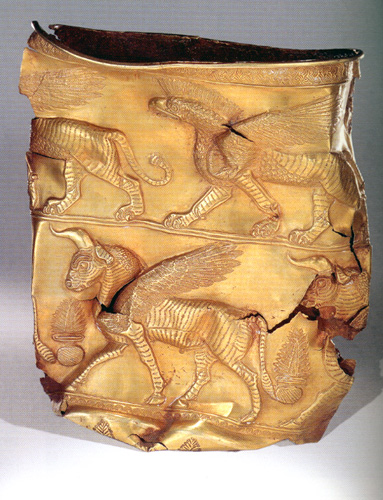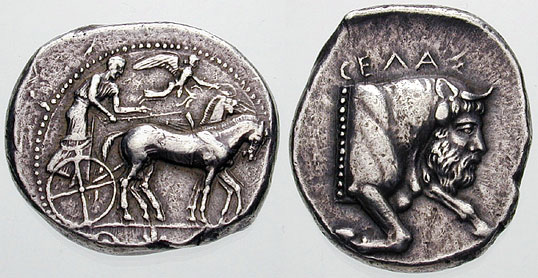Greek presence in Iran since 2nd millenium B.C.
Printed From: History Community ~ All Empires
Category: Regional History or Period History
Forum Name: Ancient Mediterranean and Europe
Forum Discription: Greece, Macedon, Rome and other cultures such as Celtic and Germanic tribes
URL: http://www.allempires.com/forum/forum_posts.asp?TID=24888
Printed Date: 20-May-2024 at 13:32
Software Version: Web Wiz Forums 9.56a - http://www.webwizforums.com
Topic: Greek presence in Iran since 2nd millenium B.C.
Posted By: Cyrus Shahmiri
Subject: Greek presence in Iran since 2nd millenium B.C.
Date Posted: 18-Jul-2008 at 14:00
|
Could it be an ancient Greek village:
Map of Kandalos in Greece: http://www.traveljournals.net/explore/greece/map/m1202089/kandalos.html - http://www.traveljournals.net/explore/greece/map/m1202089/kandalos.html
A pic: http://www.sjsu.edu/depts/PoliSci/faculty/danopoul/danopoul.htm - http://www.sjsu.edu/depts/PoliSci/faculty/danopoul/danopoul.htm
The Lost Villages of Arcadia: http://arcadia.ceid.upatras.gr/arkadia/engversion/history/lostvillages.html - http://arcadia.ceid.upatras.gr/arkadia/engversion/history/lostvillages.html
Therefore Kandalos, the god of war (it has been mentioned in http://www.allempires.net/forum_posts.asp?TID=21875&PID=403401&SID=1698z5886eaec4aa57z4ba376d455694#403401 - this thread ) was an ancient Greek village, wasn't it? Ancient Kandelos village in Iran, a unique village in the whole Iran! http://fz-az.fotopages.com/?entry=1342857 - http://fz-az.fotopages.com/?entry=1342857 http://fz-az.fotopages.com/?entry=1342178 - http://fz-az.fotopages.com/?entry=1342178
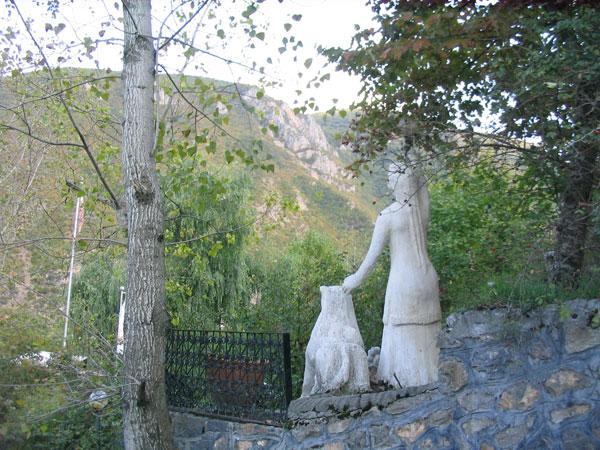 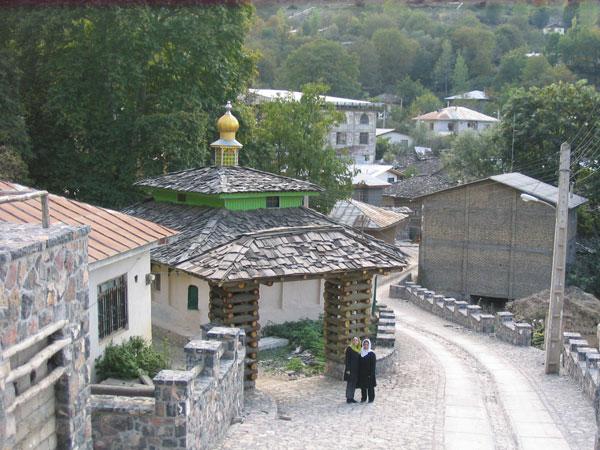 This is a mosque!!! ------------- 
|
Replies:
Posted By: Leonidas
Date Posted: 18-Jul-2008 at 14:35
|
where in Iran is this? |
Posted By: Suren
Date Posted: 18-Jul-2008 at 17:57
| In northern Iran near Caspian Sea. It is famous for candelous company. |
Posted By: Cyrus Shahmiri
Date Posted: 18-Jul-2008 at 18:53
|
As Suren said, Kandalos is located in the north of Iran at the slopes of Alborz’s range of mountains ending in the Zanos valley. This is a Persian website about Kandalos: http://www.kandelous.blogfa.com/8701.aspx - http://www.kandelous.blogfa.com/8701.aspx A pic from that website:
Artemis, the Greek goddess of war:
------------- 
|
Posted By: Cyrus Shahmiri
Date Posted: 18-Jul-2008 at 20:37
|
This statue relates to the old story of Mina and Panther (مینا و پلنگ) in Kandalos: http://www.kandelous.blogfa.com/post-75.aspx - http://www.kandelous.blogfa.com/post-75.aspx
Mina could be the Persian version of Greek Minos.
http://www.somaluna.com/prod/ariadne_statue.asp - http://www.somaluna.com/prod/ariadne_statue.asp
 Ariadne and Panther
http://www.somaluna.com/prod/ariadne_statue.asp - Ariadne was the one-time wife of http://www.somaluna.com/prod/dionysus_statue.asp - Dionysus and the daughter of King Minos and Queen Pasiphae. By some accounts King Minos was a son of http://www.somaluna.com/prod/zeus_statue.asp - Zeus . The famous Minotaur of the Labyrinth of Crete was born of Pasiphae's relation with a sacred bull. After http://www.somaluna.com/prod/ariadne_statue.asp - Ariadne helped the hero Theseus escape the Labyrinth, they escaped together, but soon Theseus abandoned her, some say pregnant, on the island of Naxos. http://www.somaluna.com/prod/dionysus_statue.asp - Dionysus found her abandoned on the island and married her there. ------------- 
|
Posted By: Flipper
Date Posted: 19-Jul-2008 at 09:21
|
if you ask me that village looks like a typical Epirotan village in the Pindus mountains... So, what is your theory about this Kyros?  I mean, how, when, what? It is a good observation i have to say. I mean, how, when, what? It is a good observation i have to say.  -------------  
Så nu tar jag fram (k)niven va! |
Posted By: Cyrus Shahmiri
Date Posted: 19-Jul-2008 at 09:45
|
Kandalos is in the west of Mazandaran province but lets see what Herodotus says about Gilaki people of Gilan province: http://www.allempires.com/EBooks/Default.asp?BookID=41&ChapterID=675 - http://www.allempires.com/EBooks/Default.asp?BookID=41&ChapterID=675 They have all deep blue eyes, and bright red hair. There is a city in their territory, called Gelonus, which is surrounded with a lofty wall, thirty furlongs each way, built entirely of wood. All the houses in the place and all the temples are of the same material. Here are temples built in honour of the Grecian gods, and adorned after the Greek fashion with images, altars, and shrines, all in wood. There is even a festival, held every third year in honour of Bacchus, at which the natives fall into the Bacchic fury. For the fact is that the Geloni were anciently Greeks, who, being driven out of the factories along the coast, fled to the Budini and took up their abode with them. They still speak a language half Greek, half Scythian. 1. Gilaki language: (also is known as Glaiki, Greek comes from "Graikoi", doesn't it?) http://en.wikipedia.org/wiki/Gilaki_language - http://en.wikipedia.org/wiki/Gilaki_language I know almost nothing about Greek language but for example doesn't "Kore" also means "Girl" in Greek? 2. deep blue eyes, and bright red hair Search for Gilan girl: http://images.google.com/images?hl=en&q=Gilan%20girl&um=1&ie=UTF-8&sa=N&tab=wi - http://images.google.com/images?hl=en&q=Gilan%20girl&um=1&ie=UTF-8&sa=N&tab=wi
Ali Larijani, the chairman of the Iranian parliament, is also from this region:
In fact Gilaki people are famous for their blue eyes, for example about Mirza Kouchak Khan of Gilan, an Iranian national hero of World War I, we read: http://www.mehrnews.com/en/NewsDetail.aspx?NewsID=10942 - http://www.mehrnews.com/en/NewsDetail.aspx?NewsID=10942 The contemporary poet Karim Rajabzadeh is to publish a collection of poetry on Mirza Kouchak Kahn Jangali under the title of “Blue Eyes of Love”. 3. Wooden houses Search for Gilan houses: http://images.google.com/images?um=1&hl=en&q=Gilan+houses - http://images.google.com/images?um=1&hl=en&q=Gilan+houses Could you find a non-wooden house?
A mosque:
------------- 
|
Posted By: Cyrus Shahmiri
Date Posted: 19-Jul-2008 at 10:16
|
Statue of Nika in phoman, Gilan province:
Nike, Greek goddess of victory:
------------- 
|
Posted By: Flipper
Date Posted: 19-Jul-2008 at 10:17
|
Thank you very much again Cyrus. Very interresting! I was unaware of the report of Herodotus. However, the blonde elements are probably not from Greece. Ancient Greeks had in majority dark brown hair. Kore means daughter, so yes it is a good observation again. -------------  
Så nu tar jag fram (k)niven va! |
Posted By: Cyrus Shahmiri
Date Posted: 19-Jul-2008 at 11:53
|
Cyrus (Kurosh means "boy" in Gilaki) was certainly not a Persian king, you read here: http://www.sacred-texts.com/afr/we/we20.htm - http://www.sacred-texts.com/afr/we/we20.htm that some Greek historians such as Ctesias called him an Amardian. http://en.wikipedia.org/wiki/Amard - http://en.wikipedia.org/wiki/Amard The Amard people, or Amardis (also Amardians, Amui in http://en.wikipedia.org/wiki/Middle_Persian - Pahlavi ) were a tribe living along the southern shore of the Caspian, including current day http://en.wikipedia.org/wiki/Amol - Amol , http://en.wikipedia.org/wiki/Iran - Iran . The name is also seen as Mardi, Mardian, Mardae, etc.
http://www.allempires.net/forum_posts.asp?TID=929&PID=63722 - http://www.allempires.net/forum_posts.asp?TID=929&PID=63722 : My Persian encyclopaedia says about Amards (Mards) as the ancestors of modern Gilakis that they were non-Aryan people of Greek Origin who in the second and first millennium BC lived in the city of Amol (Amoi) and Tonekabon in Mazandaran. ------------- 
|
Posted By: Cyrus Shahmiri
Date Posted: 20-Jul-2008 at 08:18
|
This is really interesting that Herodotus says Gilanis are half Greek, half Scythian. One of the most ancient sites in Gilan is Marlik: http://en.wikipedia.org/wiki/Marlik - http://en.wikipedia.org/wiki/Marlik
Scythian Griffin on top band:
And Greek Pegasus below:
------------- 
|
Posted By: Suren
Date Posted: 20-Jul-2008 at 10:00
        
|
Posted By: Suren
Date Posted: 20-Jul-2008 at 10:06
Cyrus, the wooden mosque is in Nishabur (khurasan Province) some thousand kilometers far from gilan province.
|
Posted By: Cyrus Shahmiri
Date Posted: 20-Jul-2008 at 12:16
|
You are right but it is not a Khorasani building, is it? Of course it is just a modern building which could be inspired from Old Mosque of Rasht: http://en.wikipedia.org/wiki/Rasht - http://en.wikipedia.org/wiki/Rasht (look at the painting) ------------- 
|
Posted By: Cyrus Shahmiri
Date Posted: 20-Jul-2008 at 17:00
|
There are some unique words in Gilaki language that you can hardly find a word for them in other languages, for exmple: http://www.chn.ir/news/?section=4&id=935 - http://www.chn.ir/news/?section=4&id=935 "از يك واژه گيلكي استفاده كردم به اسم (بيلگاس) و توضيح دادم كه يعني كسي كه دندانهايش شبيه دندانهاي اسب باشد" It says the word "Bilogas" in Gilaki language means "One who has teeth similar to a horse‘s", now lets find this word has a Greek or Scythian origin? Could it be related to this word: http://en.wikipedia.org/wiki/Bruxism - http://en.wikipedia.org/wiki/Bruxism
Bruxism (from the http://en.wikipedia.org/wiki/Greek_language - Greek βρυγμός (brugmós), gnashing of teeth) is grinding of the teeth, typically accompanied by clenching of the jaw. ------------- 
|
Posted By: Cyrus Shahmiri
Date Posted: 20-Jul-2008 at 21:23
|
Do you know where Marlik objects were found? in the largest Olive Garden in Iran.
http://en.wikipedia.org/wiki/Roudbar - http://en.wikipedia.org/wiki/Roudbar
Roodbar is also called "Roodbar Zeitoun ( http://en.wikipedia.org/wiki/Olive - olive )" for the olive gardens in the area. Marlik bowl, a famous archeological artifact and one of the oldest gold bowls in the world from http://en.wikipedia.org/wiki/1st_millennium_BC - 1st millennium BC was found in Roodbar http://www.iranian.com/History/June97/Marlik/index.shtml - [1] , http://i-cias.com/e.o/marlik.htm - [2] . Despite the olive gardens that may suggest presence of a Mediterranean climate, the winters are very cold in the area. Roodbar was near the epicenter of an http://en.wikipedia.org/wiki/Earthquake - earthquake of magnitude 7.3 http://en.wikipedia.org/wiki/Richter - Richter (MS=7.7, MW=7.3, mb=6.4) at 12:31am on June 21, http://en.wikipedia.org/wiki/1990 - 1990 local time that killed at least 6,000 and injured 10,000 city residents. [ Abbas Kiarostami (an Iranian film director) made his famous film "Through the Olive Trees" based upon this event. -> http://en.wikipedia.org/wiki/Through_the_Olive_Trees - http://en.wikipedia.org/wiki/Through_the_Olive_Trees ]
More info about Marlik: http://i-cias.com/e.o/marlik.htm - http://i-cias.com/e.o/marlik.htm (a large rocky mound surrounded by http://i-cias.com/e.o/olive.htm - olive groves)
I think those are olive trees beside the winged-horses (Pegasus) on that Marlik Golden Cup, anyway it is obvious that Gilakis loved this region because it resembled their mother land (Greece). ------------- 
|
Posted By: Cyrus Shahmiri
Date Posted: 21-Jul-2008 at 07:05
|
About Traditional Gilaki Costumes: http://cyberfaith.blogspot.com/2008/04/rural-heritage-of-guilan-green-smile-of.html - http://cyberfaith.blogspot.com/2008/04/rural-heritage-of-guilan-green-smile-of.html
------------- 
|
Posted By: Cyrus Shahmiri
Date Posted: 21-Jul-2008 at 08:08
|
It seems to be a good research for me! The region in the east of Gilan and the west of Mazandaran provinces is known as Halan or Halestan (land of Hales). Search for Halestan: http://www.google.com/search?hl=en&q=Halestan - http://www.google.com/search?hl=en&q=Halestan Map of Halestan in the east of Gilan province: http://www.traveljournals.net/explore/iran/map/m5031763/halestan.html - http://www.traveljournals.net/explore/iran/map/m5031763/halestan.html Map of Halestan in the west of Mazandarn province: http://www.traveljournals.net/explore/iran/map/m5080658/halestan.html - http://www.traveljournals.net/explore/iran/map/m5080658/halestan.html The longest river of this region: Chalus (the word is similar to "Chios", an island in Greece)
http://www.pars-iran.tripod.com/chalus.htm - http://www.pars-iran.tripod.com/chalus.htm : Chalus River with 80km long comes from Kandovan Mountain then it graft to Caspian Sea on Chalus city (small city on east of Mazandaran province).
Xenophon has mentioned a Chalus river: http://www.allempires.com/EBooks/Default.asp?BookID=60&ChapterID=974 - http://www.allempires.com/EBooks/Default.asp?BookID=60&ChapterID=974
"After this Cyrus marched onwards four stages--twenty parasangs--to the river Chalus." (ANABASIS, by Xenophon: Book 1) The highest mount of this region: Samamos (the word is similar to Samos, an island in Greece)
Website: http://www.somamus.com - http://www.somamus.com http://hezarbareshgh.blogfa.com/post-668.aspx - http://hezarbareshgh.blogfa.com/post-668.aspx : The peak Soomamoos is part of the Alborz mountain range in the North of Iran. The peak of the Soomamoos extend through the provinces of Gilan and Mazandaran. Soomamoos Peak, has an elevation of 3720 m and it is the tallest summit in Gilan province. ------------- 
|
Posted By: Cyrus Shahmiri
Date Posted: 21-Jul-2008 at 10:07
|
This Persian website: http://www.aftab.ir/travel/iran/gilan/geography/human.php - http://www.aftab.ir/travel/iran/gilan/geography/human.php says anicient Gilakis believed in multiple gods (Polytheism), one of their known gods was "Gil-Agames", a hero which is known by Sumerians as "Gilgamesh" and Greeks "Agamedes/Agamemnon". http://www.cais-soas.com/News/2005/December2005/15-12.htm - http://www.cais-soas.com/News/2005/December2005/15-12.htm (CIAS: The Circle of Ancient Iranian Studies): The civilization thrived along the banks of Mardi (or Amardi) River (Sepid Roud) and the nearby plains. ------------- 
|
Posted By: Cyrus Shahmiri
Date Posted: 21-Jul-2008 at 10:48
|
It is true that "Gile" means Ship in Gilaki language, of course I don't know their name relates to this word or not.
There is also a similar Greek word: http://en.wikipedia.org/wiki/Galley - http://en.wikipedia.org/wiki/Galley
A galley (from http://en.wikipedia.org/wiki/Greek_language - Greek γαλέα - galea) is an ancient http://en.wikipedia.org/wiki/Ship - ship which can be propelled entirely by human http://en.wikipedia.org/wiki/Watercraft_rowing - oarsmen , used for http://en.wikipedia.org/wiki/Warfare - warfare and http://en.wikipedia.org/wiki/Trade - trade .
Galleys fought in the wars of ancient http://en.wikipedia.org/wiki/Persian_Empire - Persia , http://en.wikipedia.org/wiki/Ancient_Greece - Greece , http://en.wikipedia.org/wiki/Carthage - Carthage and http://en.wikipedia.org/wiki/Ancient_Rome - Rome until the 4th century.
Galleys traversed the http://en.wikipedia.org/wiki/Mediterranean - Mediterranean from around http://en.wikipedia.org/wiki/30th_century_BC - 3000 BC . The http://en.wikipedia.org/wiki/Phoenicia - Phoenicians and the http://en.wikipedia.org/wiki/Greeks - Greeks built and operated the first known ships to navigate the Mediterranean: merchant vessels with http://en.wikipedia.org/wiki/Square-rigged - square-rigged sails.
The development of the http://en.wikipedia.org/wiki/Ram_bow - ram in about http://en.wikipedia.org/wiki/8th_century_BC - 800 BC changed the nature of naval warfare, which had until that point involved boarding and hand-to-hand fighting. Now a more maneuverable ship could render a slower ship useless by staving in its sides. We do not know for sure if the winners of naval battles usually actually sank their opponents; the same Greek word can mean "sunk" or "waterlogged", and reports survive of victorious galleys towing the defeated ship away after a battle. ------------- 
|
Posted By: HEROI
Date Posted: 21-Jul-2008 at 13:04
Flipper you yourself made a very good observation when you said that the village looks Epirotan,it looks indeed Epirotan,since i am myself from south of Albania and we have extremely similar villages.The homes are exactly the same,i will bring some pictures latter.
About the Blonde element you might be wrong.The cities in south Albania have majority dark brown hair,but is not the same for the villages and the rural areas,there people have mainly blond hair and red hair is very common,specially i would say children are overwhelmingly blond haired.I think is the same for Villages in Greece on the borders with Albania.The Cham population for example (which of course come from Greece) are mainly blond aswell.
I will hopefully get some pictures soon.
By the way that was such an beautifull place.Thanks for this nice pictures. ------------- Me pune,me perpjekje. |
Posted By: HEROI
Date Posted: 21-Jul-2008 at 13:40
|
Lets have a look at the simmilarities,this are some pictuires from south Albania.
http://www.galeriashqiptare.net/albums/Shqiperia/010919-422-b.jpg">
 http://www.galeriashqiptare.net/albums/Shqiperia/Berat_2003B.jpg">
 http://www.galeriashqiptare.net/albums/Shqiperia/gjirokastra.jpg">
 http://www.galeriashqiptare.net/albums/userpics/gjirokaster.jpg">
 And now some pictures from Albanian Villages in Italy,this Albanian people have come to Italy many centuries ago from Albania and from Morea,and many other places in Greece,mainly Epiros.
    So i think we can see a great simmilarity between Epiros and this place in Iran.
------------- Me pune,me perpjekje. |
Posted By: HEROI
Date Posted: 21-Jul-2008 at 14:03
Take a look at the simmilarities
http://www.galeriashqiptare.net/albums/userpics/10067/berati2.jpg">
 http://www.galeriashqiptare.net/albums/userpics/10067/qytetigjirokaster.jpg">
  Are not this striking simmilarities????????
I think one should not exlude the Ottoman element there,but still the essence of it is Epiros. ------------- Me pune,me perpjekje. |
Posted By: Vorian
Date Posted: 21-Jul-2008 at 19:13
|
All those villages exist in similar areas so it's obvious that people would find similar solutions in architecture. |
Posted By: HEROI
Date Posted: 21-Jul-2008 at 21:04
|
Perhaps,all i am saing is that the architectural style is very simmilar.
And is strange that this specific Epirotan style,which for example can not be found in other simmilar places near Epiros (by Epiros i always refer to South of Albania and the north of Greece),for example can not be found in Eastern Greece or Macedonia,or Northern Albania,can not be found in any other country,but can be found in a village in Iran then this is strange.I would say that is possible that people from Epiros have once settled for one reason or another in this Iranian village.Why not?
By the way,this style of Village is found in Italy aswell,as i have brought pictures to prove it.
Not only in Albanian areas of Italy,but Greek areas as well,is very similar style of Villages.
Also Sicilian and southern Italian Villages in general are very simillar to the ones i have posted above. ------------- Me pune,me perpjekje. |
Posted By: Cyrus Shahmiri
Date Posted: 21-Jul-2008 at 23:33
|
Architecture certainly relates to climate, outer environment and other things, it is obvious that if Greeks migrated to the deserts of Iran, they wouldn't build these gable-roof houses there, but as Heroi said why we can't find similar villages in other countries? I think the most important thing is "culture", there should be a reason that the houses of Gilan are being built entirely of wood, as Herodotus said about 2,500 years ago, nothing has been changed, but this Kandalos village is completely different, and we see Darius the Great about his palace says "The stone-cutters who wrought the stone, those were all Greeks". ------------- 
|
Posted By: Cyrus Shahmiri
Date Posted: 22-Jul-2008 at 08:22
|
About Epirus: http://www.greecetaxi.gr/index/epirus_zagoria.html - http://www.greecetaxi.gr/index/epirus_zagoria.html The area may be depopulated today, but the beautiful large private homes and public buildings are a testament to the flourishing past. Their grey, heavy stone roofs rise over the thick vegetation. Stone-paved streets cross the villages. The houses are built with stones and wood, and their walls are thick to withstand the harsh weather conditions and the winter snow. Stone-built walls surround the yards, which are guarded by beautiful, heavy, wooden gates. Fortunately, many of these buildings now have been restored and modernized properly, and several have been turned into hotels and pensions, retaining the traditional style. What is more important is that the area has kept its serenity and is rarely crowded with people ..
http://www.cais-soas.com/News/2006/October2006/07-10-3000.htm - http://www.cais-soas.com/News/2006/October2006/07-10-3000.htm : LONDON, (CAIS) -- Archeologists in the ancient site of Gohar Tappeh (also Tepe -an archaeological mound), northern Iran, discovered a street with stone pavements belonging to nearly 3000 years ago. ------------- 
|
Posted By: Flipper
Date Posted: 22-Jul-2008 at 09:52
Basically, stone architecture is used in many places around Greece, like for example Eubia, Peloponesus, Chalkidiki, Pelion and some islands. However, the Pindus architecture is unique that's why i mentioned it. The Pindus architecture is different that for example the one in Ioanina or other places in Epirus. As for my grandfathers family, they were stonecutters from western macedonia, just 15km from the Pindus chain. The family was offered a job in Istanbul as stone artisans and then moved to Bursa to settle for some time. -------------  
Så nu tar jag fram (k)niven va! |
Posted By: Flipper
Date Posted: 22-Jul-2008 at 09:55
Heroi, the blonde element went for the Gilakis who were half Greek, half Scythian. The connection Cyrus made was to Arcadia not Pindus in Epirus which was mentioned because it keeps traditional architecture. Albanians can be light haired but that is irrelevant. Ancient Greeks were usually brown/dark brown. -------------  
Så nu tar jag fram (k)niven va! |
Posted By: Flipper
Date Posted: 22-Jul-2008 at 10:00
Heroi, the Pindus (not specifically Epirus) architecture is found in south western (or upper) macedonia (Boia) as well. Also, Pelion in Thessaly is known for its stone architecture combined with wood. Stone villages otherwise can be found everywhere in Greece depending on the environment. The same goes for every place in the balkans. Also, the settlers are supposed to be Arcadians. -------------  
Så nu tar jag fram (k)niven va! |
Posted By: Flipper
Date Posted: 22-Jul-2008 at 10:04
Generally Cyrus, very good post!  I have learned something new. I have learned something new.I was amazed by the golden depictions of those Gilaki creatures. The idea of a local cult based on a mix of Babylonian and Greek mythology is intriguing. -------------  
Så nu tar jag fram (k)niven va! |
Posted By: Cyrus Shahmiri
Date Posted: 22-Jul-2008 at 21:22
|
You are welcome! As I said, Kandelos vilage is near the Zanos valley (west Mazandaran), what could be the meaning of Zanos? This Persian website:http://rezafaraji.blogfa.com/post-223.aspx says "تلفظ مي كنند (Zanes) زانوس را زانس" Zanus is pronounced "Zanes" in the local language. http://gogreece.about.com/od/mythology/a/olympicmyths.htm - http://gogreece.about.com/od/mythology/a/olympicmyths.htm -> Statues called "Zanes", based on the ancient Cretan name of Zeus, Zan. http://www.zoniana.gr/name_en.htm - http://www.zoniana.gr/name_en.htm -> Even today one of the valleys of Mount Ida in Crete is named “Zeus’ Valley – Zoulakkos” and a common invocation of the inhabitants is: “May Zeus lend a favourable ear to me” (“Ikoute me Zone Thee”). Therefore "Zan/Zanes/Zone" could mean "Zeus" in Greek.
Lets create a false etymology for Mazandaran: Mega-Zan-Doron "Gift of the great Zeus"?
At least I think it is better than "mahs Indra" (Great/Big Indra, a vedic god) which has been mentioned in several websites, such as: http://www.economicexpert.com/a/Mazandaran.htm - http://www.economicexpert.com/a/Mazandaran.htm ------------- 
|
Posted By: Cyrus Shahmiri
Date Posted: 23-Jul-2008 at 09:12
|
I believe the Old Greek word for "Dragonfly" was "Chichilas" or "Chrichilas", wasn't it? The Gilaki word is Chichilas: http://foto.ir/Gallery/ShowImage.aspx?ID=26595 - http://foto.ir/Gallery/ShowImage.aspx?ID=26595
It could be related to Chrysalis: http://en.wikipedia.org/wiki/Pupa#Chrysalis - http://en.wikipedia.org/wiki/Pupa#Chrysalis A chrysalis ( http://en.wikipedia.org/wiki/Latin - Latin chrysallis, from http://en.wikipedia.org/wiki/Greek_language - Greek χρυσαλλίς = chrysallís, pl: chrysalides) or nympha is the pupal stage of http://en.wikipedia.org/wiki/Butterfly - butterflies . The term is derived from the metallic gold-colouration found in the pupae of many butterflies referred to by the http://en.wikipedia.org/wiki/Greek_language - Greek term χρυσός (chrysós) for gold.------------- 
|
Posted By: Yiannis
Date Posted: 23-Jul-2008 at 11:36
|
In case I'm adding something to this discussion: most -if not all- of the golden Scythian artifacts were crafted by Greek artists from the Black sea colonies, not by Scythes themselves. ------------- The basis of a democratic state is liberty. Aristotle, Politics Those that can give up essential liberty to obtain a temporary safety deserve neither liberty nor safety. Benjamin Franklin |
Posted By: Leonidas
Date Posted: 23-Jul-2008 at 12:26
Not to be a wet blanket, but while we may find something Greek about this village. The people in that part of Iran, are distinctively Iranian in their background. The languages up in that Gilan-mazarandan (sp?) area have been quite isolated from foreign language interference, unlike Parsi- oops Farsi . Flipper, much like Tsakonian. The archaisms themselves, i suspect make names look similar. . Flipper, much like Tsakonian. The archaisms themselves, i suspect make names look similar.I would make an educated guess, their genetics are also isolated. but i will need to search around to see if that a fact. Mountain people preserve archaisms. I guess if there was a passing hellenic infleunce (endless possbilities) it may have clung on in this village. |
Posted By: Cyrus Shahmiri
Date Posted: 23-Jul-2008 at 16:18
|
I found some interesting info: http://www.classicistranieri.com/english/1/9/1/5/19153/19153-h/19153-h.htm - http://www.classicistranieri.com/english/1/9/1/5/19153/19153-h/19153-h.htm SAN, SON, ZAN, ZAAN. [136]Ὡδε μεγας κειται Ζαν, ὁν Δια κικλησκουσι. The Ionians expressed it Ζην, and Ζηνα. Hesychius tells us, that the Sun was called Σαως by the Babylonians. It is to be observed that the Grecians in foreign words continually omitted the Nu final, and substituted a Sigma. The true Babylonish name for the Sun was undoubtedly Σαων, oftentimes expressed Σωαν, Soan. It was the same as Zauan of the Sidonians; under which name they worshipped Adonis, or the Sun. Hesychius says, Ζαυανας, θεος τις εν Σιδωνι. Who the Deity was, I think may be plainly seen. It is mentioned by the same writer, that the Indian Hercules, by which is always meant the chief Deity, was styled Dorsanes: Δορσανης ὁ Ἡρακλης παρ' Ινδοις. The name Dorsanes is an abridgment of Ador-San, or Ador-Sanes, that is Ador-Sol, the lord of light. It was a title conferred upon Ham; and also upon others of his family; whom I have before mentioned to have been collectively called the Baalim. http://penelope.uchicago.edu/Thayer/E/Gazetteer/Topics/astronomy/_Texts/secondary/ALLSTA/Hercules*.html - http://penelope.uchicago.edu/Thayer/E/Gazetteer/Topics/astronomy/_Texts/secondary/ALLSTA/Hercules*.html
Almannus and Celticus came from the fact that a similar hero was worshiped by the Germans and Celts, themselves noted for strength and daring deeds, and said to have been descended from Hercules. The unexplained Pataecus and Epipataecus are from Egypt; Maceris, from Libya; while Desanaus, Desanes, and Dosanes, or Dorsanes, are said to be of Hindu origin. ------------- 
|
Posted By: Cyrus Shahmiri
Date Posted: 23-Jul-2008 at 16:42
|
http://www.ancientlibrary.com/smith-bio/1509.html - http://www.ancientlibrary.com/smith-bio/1509.html The Cretan Heracles, one of the Idaean Dactyls, was believed to have founded the temple of http://www.ancientlibrary.com/smith-bio/3655.html - Zeus at Olympia (Paus. v. 13. § 5), but to have originally come http://www.ancientlibrary.com/smith-bio/3733.html - from Egypt. (Diod. iv. 18.) The traditions about him resemble those of the Greek Heracles (Diod. v. 76 ; Paus. ix. 27. § 5) ; but it is said that he lived at a much earlier period than the Greek hero, and that the latter only imitated him. http://www.ancientlibrary.com/smith-bio/1226.html - Eusebius states that his name was Diodas, and http://www.ancientlibrary.com/smith-bio/1567.html - Hieronymus makes it Desanaus. He was worshipped with funeral sacrifices, and was regarded as a magician, like other ancient daemones of http://www.ancientlibrary.com/smith-bio/0899.html - Crete . (Cic. de Nat. Deor. iii. 16 ; Diod. v, 64.)------------- 
|
Posted By: Cyrus Shahmiri
Date Posted: 23-Jul-2008 at 17:17
|
Assyrians have called people of Gilan and Mazandaran as "Spartans", their land "Sparta/Sparda" and one of their king "Dosanes".
For example, the queries of Esarhaddon, king of Assyria, to the sun-god:
http://cdl.museum.upenn.edu/cgi-bin/cdlpager?caller=knp;project=saa - http://cdl.museum.upenn.edu/cgi-bin/cdlpager?caller=knp;project=saa
Years of Alulim
Will Kaštaritu Conquer Karibtu Should Esarhaddon Send his Messenger to Kaštaritu Will Dusanni of Saparda or Kaštaritu Appear before the City Fragmentary Query Concerning Kaštaritu Will Kaštaritu or Dusanni Conquer Kilman Will Chief Eunuch Ša-Nabu-šu Capture Amul You can find those place and people names, here: http://knp.prs.heacademy.ac.uk/peoplegodsplaces/ - http://knp.prs.heacademy.ac.uk/peoplegodsplaces/
As you read it has also mentioned that Amul is modern Amol in Mazandaran province: http://en.wikipedia.org/wiki/Amol - http://en.wikipedia.org/wiki/Amol
------------- 
|
Posted By: Cyrus Shahmiri
Date Posted: 23-Jul-2008 at 17:51
http://daimonas.com/pages/griffin.html - http://daimonas.com/pages/griffin.html
The internet should never be the primary source for information, and should always be used with extreme caution. This page has come into existence because I stumbled upon an internet site dedicated to the griffin (alernately: "gryphon", "gryps"). On that site the author stated that the griffin was adopted by Greeks from the Scythians in the 6th century BC... and the reasoning proffered as a means of supporting this hypothesis was that the author of that page had never encountered the griffin's role in any Greek myth. This page contains griffins from the Greek world that are one thousand years older than the Scythian-adoption claim made on that site. The earliest depictions of griffins occur on the Greek island of Thera and date to the 17th century BC or earlier. In the Wikipedia entry on the griffin, the Aegean griffins are entirely omitted, hence creating the impression that the origin of the griffin lies instead in the Near East. What is depicted is a griffin from Marlik, Iran (pictured below), which dates to between the 12th - 13th centuries BC (c. 1250-1150 BC). The griffins of the Aegean predate the Marlik griffin by 400 years.
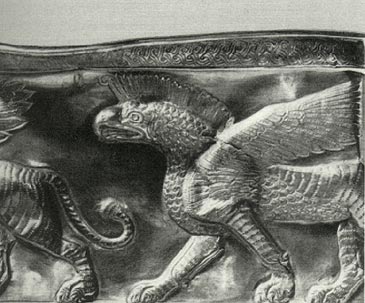 ------------- 
|
Posted By: Cyrus Shahmiri
Date Posted: 23-Jul-2008 at 20:31
People of Gilan and Mazandaran are certainly Iranian peoples, there is no doubt, but what is your definition of Iranian? People who live in Iran or speak an Iranian language? However I myself belive Gilaki is also an Iranian langugae but I have to admit that there are some important grammatical and lexical differences between Gilaki and other Iranian languages, even Mazandarani language, some of those difference have been mentioned here: http://en.wikipedia.org/wiki/Gilaki_language - http://en.wikipedia.org/wiki/Gilaki_language ------------- 
|
Posted By: Cyrus Shahmiri
Date Posted: 23-Jul-2008 at 21:11
|
It seems an Indian people also claim to be Greek! http://en.wikipedia.org/wiki/Gill_%28clan - http://en.wikipedia.org/wiki/Gill_(clan ) The modern Jat tribe of Gills are lineage from the King or Raja, Prithipat of Garh Mathila who was a Waryah Rajput. Thus, the Jat tribe of Gills is believed to fit under the branch of a predecessor umbrella Gill tribe that ranged from Central Asia through modern-day http://en.wikipedia.org/wiki/Iran - Iran , http://en.wikipedia.org/wiki/Afghanistan - Afghanistan , http://en.wikipedia.org/wiki/Pakistan - Pakistan , and North Western http://en.wikipedia.org/wiki/India - India . This tribe according to sources below is believed to have been of either http://en.wikipedia.org/wiki/Indo-Iranian - Indo-Iranian origins from Central Asia, (specifically http://en.wikipedia.org/wiki/Scythian - Scythian or http://en.wikipedia.org/wiki/Saka - Saka from their home on the http://en.wikipedia.org/wiki/Oxus - Oxus , or possibly http://en.wikipedia.org/wiki/White_Huns - White Huns or http://en.wikipedia.org/wiki/Yuezhi - Yuezhi ) or a mixed http://en.wikipedia.org/wiki/Indo-Scythian - Indo-Scythian and http://en.wikipedia.org/wiki/Greeks - Greek tribe. The Indo-Aryan/Greek mix theory is due in part to tradition passed down through the tribe for over the last millennia as well as the timeframe in which Scythians/Yuezhi/White Huns which were competing Central Asian tribes of Indo-European descent settled in Asia and established kingdoms, such as the Indo-Scythian kingdom, and the geographical and chronological range of this settlement coinciding with http://en.wikipedia.org/wiki/Alexander_the_Great - Alexander the Great 's invasion with his Greek army.Theory of Greek origin
http://en.wikipedia.org/wiki/Bhim_Singh_Dahiya - Bhim Singh Dahiya , a prominent Jat historian, traces the origin of the Gills to the http://en.wikipedia.org/wiki/Greeks - Greeks . He speculates that the people of this tribe which was possibly http://en.wikipedia.org/wiki/Indo-Scythian - Indo-Scythian came in the company of http://en.wikipedia.org/wiki/Alexander_the_Great - Alexander the Great . They settled in http://en.wikipedia.org/wiki/Kabul - Kabul , http://en.wikipedia.org/wiki/Kandhar - Kandhar and the Punjab region. One of the sons of the legendary Greek mythical hero, http://en.wikipedia.org/wiki/Hercules - Hercules was named "Gilla." It is also possible that ancestors of Gills came to http://en.wikipedia.org/wiki/Greece - Greece from Middle http://en.wikipedia.org/wiki/Asia - Asia ( http://en.wikipedia.org/wiki/Scythians - Scythians / http://en.wikipedia.org/wiki/Sakas - Sakas ) and then to what is now Pakistan, and http://en.wikipedia.org/wiki/Afghanistan - Afghanistan . This would conform with typical Jat ancestry,[ http://en.wikipedia.org/wiki/Wikipedia:Citation_needed - citation needed ] distinguishing the Gill clan in particular as migrating/invading peoples from the http://en.wikipedia.org/wiki/Parthian - Parthian Greek or http://en.wikipedia.org/wiki/Greco-Bactrian - Greco-Bactrian Kingdoms, which sprang up after Alexander's incursion. These would be a mix of ethnically Greek or Indo-Scythian ( http://en.wikipedia.org/wiki/Indo-Iranian - Indo-Iranian ) peoples, whereas most Jat clans are typically descended from Indo-Scythian/Saka migrations/invasions from the north ( http://en.wikipedia.org/wiki/Central_Asia - Central Asia and Western http://en.wikipedia.org/wiki/China - China ).[ http://en.wikipedia.org/wiki/Wikipedia:Citation_needed - citation needed ] The http://en.wikipedia.org/wiki/Shahi - Shahi Dynasty of Afghanistan and the Punjab, and many of the rulers of Greco-Bactrian kingdoms post-Alexander were also from the Gill clan. ------------- 
|
Posted By: Vorian
Date Posted: 23-Jul-2008 at 22:28
Interesting how all these people don't turn to FYROM but us! Sorry for the thread hi-jacking. |
Posted By: Leonidas
Date Posted: 24-Jul-2008 at 04:46
|
one person claims, lets not get excited. the connection would be PIE, most like indo-Iranic. I still fail to see the Greek connection in terms of language.
the part of that wiki article which i have come across before, which is quite relevant is this part.
|
Posted By: Leonidas
Date Posted: 24-Jul-2008 at 04:50
futher
|
Posted By: Cyrus Shahmiri
Date Posted: 24-Jul-2008 at 10:24
|
Leonidas, We are not just talking about the name similarities, for example I think "Olive" could be also a good clue.
However the Olive tree is already native to Gilan alongside the eastern Mediterranean regions -> http://en.wikipedia.org/wiki/Olive - http://en.wikipedia.org/wiki/Olive but it said it was introduced to this region by the Mediterranean peoples about 3,000 years. ------------- 
|
Posted By: Greek Hoplite
Date Posted: 26-Jul-2008 at 18:42
Do exist people, like the girl in the picture in Iran?! She could be my sister lol EDIT by Spartakus: Inappropriate and totally irrelevant posting. Be careful next time. ------------- My blog http://mankap.blogspot.com/ |
Posted By: Suren
Date Posted: 26-Jul-2008 at 19:05
| Yes, they exist in Iran, but they are in minority. Most of Iranians have dark hair. |
Posted By: Greek Hoplite
Date Posted: 26-Jul-2008 at 19:08
Yes i know that, the opposite would be strange  . .------------- My blog http://mankap.blogspot.com/ |
Posted By: Cyrus Shahmiri
Date Posted: 26-Jul-2008 at 20:26
|
Marlik (intertwined snakes) http://dooroodiran.blogspot.com/2004/04/marlik-culture.html - http://dooroodiran.blogspot.com/2004/04/marlik-culture.html : Some researchers believe that Marlik has attained its name from the innumerable snakes that have inhabited it. (As 'Mar' means snake in the Persian language). I think this is the most famous Marlik gold object:
Read this thread: http://www.allempires.net/forum_posts.asp?TID=8399 - Cadusian Governmental Citadel Discovered in Gilan And read this article: http://www.tribwatch.com/delymite.htm - THE DOUBLE HELIX OF THE CADUCEUS (Cadusia is where Hermes originated.)
------------- 
|
Posted By: Cyrus Shahmiri
Date Posted: 27-Jul-2008 at 14:07
|
Gilakis and Mazanis in the west Urmia (Ninth Century B.C.) [Rabat/Musasir (West Azarbaijan province)] http://www.cais-soas.com/News/2003/October2003/25-10.htm - http://www.cais-soas.com/News/2003/October2003/25-10.htm
Gilzan
In the ancient times, the west bank of Urmia lake was called Gilzan, and in the ninth century B.C. an independent government ruled there which later joined the Urartu or Mana empire; in the eight century B.C., the area was a vassal of the Asuzh government until it joined the Mad empire after its formation.
http://www.mehrnews.ir/en/NewsDetail.aspx?NewsID=241573 - http://www.mehrnews.ir/en/NewsDetail.aspx?NewsID=241573
Naked goddesses discovered in Rabat Tepe
A brick bearing bas-reliefs of two naked winged goddesses was unearthed at the 3000-year-old site of Rabat near the town of Sardasht in Iran's West Azarbaijan Province, the Persian service of the Cultural Heritage News (CHN) agency reported on Saturday.
“This is first time such motifs (naked goddesses) were discovered in an archaeological site of the country. The importance of the discoveries created a worldwide media frenzy,” said Reza Heydari, an archaeologist of the West Azarbaijan Cultural Heritage and Tourism Department. “The discovery of naked winged goddesses in the region has astounded everyone. The goddesses are lean. Thus the archaeologists believe that they are not goddesses of reproduction and fertility,” he added. >> “Naked goddesses have frequently been seen in ancient Greek art." << The team of archaeologists working in the region believes that Rabat Tepe was the seat of government of Musasir about 3000 years ago. Musasir was a semi-independent buffer state bordering Mannai between Assyria and Urartu. It was a vassal state of Assyria yet Urartu had some claims over it. http://www.chnpress.com/news/?Section=2&id=5871 - http://www.chnpress.com/news/?Section=2&id=5871 Musasir Temple discovered in Rabat Tepe
Remains discovered in Rabat Tepe tell of a temple belonging to the Musasir civilization.
Archaeologists believe remains they have discovered in Rabat Tepe, North West of Iran, belong to a Musasir civilization temple, probably leading to the discovering of nation-states Sargon occupied some 3000 years ago. http://www.geocities.com/paris/leftbank/6507/chronicle400.html#musasir - http://www.geocities.com/paris/leftbank/6507/chronicle400.html#musasir Musasir Temple, the Prototype of the Classical Greek Temples
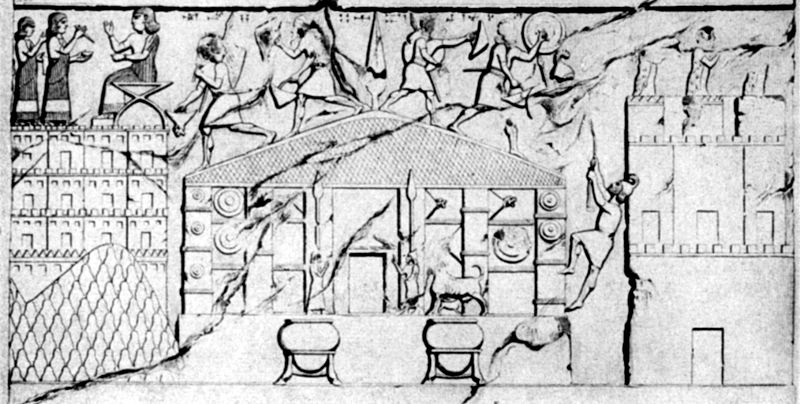
------------- 
|
Posted By: Cyrus Shahmiri
Date Posted: 02-Aug-2008 at 17:32
|
Amlash http://en.wikipedia.org/wiki/Amlash_County - http://en.wikipedia.org/wiki/Amlash_County Amlash County (Persian: شهرستان املش) is a county in Gilan Province in Iran. The capital of the county is Amlash. Amlash is also the name of an important culture which is well represented in all major museums as well as important private collections and galleries of ancient art. These persian websites mention that some archaeologists, historians and scholars, such as Professor Andre Godard, believe that Amlash culture almost certainly relates to Greek and Etruscan cultures: http://guilan.irib.ir/index.php?option=com_content&task=view&id=1256&Itemid=241 - http://guilan.irib.ir/index.php?option=com_content&task=view&id=1256&Itemid=241 پروفسور آندره گدار كه اولين رئيس مؤسسه ي باستان شناسي ايران بود ، جنس اشياي به دست آمده از گورستان هاي نواحي املش ، پيركوه ، ديلم و ديگر روستاها را بيشتر از سفال سرخ رنگ دانسته است. طبق نظر او در گورستان هاي ديلم ، اشياي سفالي منقوش اگر هم وجود داشته باشد كشف نشده است ، اما مقدار زياد اشياي طلا و نقره كشف شده در اين ناحيه نشان مي دهد تزئينات آنها گاهي با هنر يوناني ها يا هنر آتروسك وابسته بوده است. http://iran-travel.blogfa.com/post-72.aspx - http://iran-travel.blogfa.com/post-72.aspx تز ئینات انسانی آنها به خصوص از نظر فیگور و حرکت بدن نحوه قرار گرفتن پرسوناژ وحالت رزمی یا جنگی که بخود گرفته سبب شد کارشناسان آنها را با هنر یونانی و هنر اتروسک ( ناحیه ای در ایتالیای مرکزی ) خویشاوند بدانند . این آثارمربوط به اواخر هزاره دوم و اوایل هزاره اول قبل از میلاد می باشند. ------------- 
|
Posted By: Cyrus Shahmiri
Date Posted: 02-Aug-2008 at 18:09
|
Strabo (64 BC – 24 AD), the famous Greek historian and geographer, about Gilakis (Gelae), Cadusians (Cadusii), Amardians (Amardi) and other peoples who lived in the north of Iran, says: http://www.perseus.tufts.edu/cgi-bin/ptext?doc=Perseus:text:1999.01.0198&query=section%3D%23477 - http://www.perseus.tufts.edu/cgi-bin/ptext?doc=Perseus:text:1999.01.0198&query=section%3D%23477
Those nomads, however, who live along the coast on the left as one sails into the http://www.perseus.tufts.edu/cgi-bin/vor?type=phrase&alts=0&group=typecat&lookup=Caspian%20Sea&collection=Perseus:collection:Greco-Roman - Caspian Sea are by the writers of today called http://www.perseus.tufts.edu/cgi-bin/vor?type=phrase&alts=0&group=typecat&lookup=D%C3%A4ae&collection=Perseus:collection:Greco-Roman - Däae , I mean, those who are surnamed http://www.perseus.tufts.edu/cgi-bin/vor?type=phrase&alts=0&group=typecat&lookup=Aparni&collection=Perseus:collection:Greco-Roman - Aparni ; then, in front of them, intervenes a desert country; and next comes http://www.perseus.tufts.edu/cgi-bin/vor?type=phrase&alts=0&group=typecat&lookup=Hyrcania&collection=Perseus:collection:Greco-Roman - Hyrcania , where the Caspian resembles an open sea to the point where it borders on the Median and Armenian mountains. The shape of these mountains is crescent-like along the foothills, which end at the sea and form the recess of the gulf. This side of the mountains, beginning at the sea, is inhabited as far as their heights for a short stretch by a part of the Albanians and the Armenians, but for the most part by http://www.perseus.tufts.edu/cgi-bin/vor?type=phrase&alts=0&group=typecat&lookup=Gelae&collection=Perseus:collection:Greco-Roman - Gelae , http://www.perseus.tufts.edu/cgi-bin/vor?type=phrase&alts=0&group=typecat&lookup=Cadusii&collection=Perseus:collection:Greco-Roman - Cadusii , http://www.perseus.tufts.edu/cgi-bin/vor?type=phrase&alts=0&group=typecat&lookup=Amardi&collection=Perseus:collection:Greco-Roman - Amardi , Vitii, and http://www.perseus.tufts.edu/cgi-bin/vor?type=phrase&alts=0&group=typecat&lookup=Anariacae&collection=Perseus:collection:Greco-Roman - Anariacae . They say that some of the http://www.perseus.tufts.edu/cgi-bin/vor?type=phrase&alts=0&group=typecat&lookup=Parrhasii&collection=Perseus:collection:Greco-Roman - Parrhasii took up their abode with the http://www.perseus.tufts.edu/cgi-bin/vor?type=phrase&alts=0&group=typecat&lookup=Anariacae&collection=Perseus:collection:Greco-Roman - Anariacae , who, they say, are now called http://www.perseus.tufts.edu/cgi-bin/vor?type=phrase&alts=0&group=typecat&lookup=Parsii&collection=Perseus:collection:Greco-Roman - Parsii ; and that the http://www.perseus.tufts.edu/cgi-bin/vor?type=phrase&alts=0&group=typecat&lookup=Aenianes&collection=Perseus:collection:Greco-Roman - Aenianes built a walled city in the Vitian territory, which, they say, is called Aeniana; and that http://www.perseus.tufts.edu/cgi-bin/vor?type=phrase&alts=0&group=typecat&lookup=Greek&collection=Perseus:collection:Greco-Roman - Greek armour, brazen vessels, and burial places are to be seen there; and that there is also a city Anariace there, in which, they say, is to be seen an oracle for sleepers, http://www.perseus.tufts.edu/cgi-bin/ptext?doc=Perseus:text:1999.01.0198&query=section%3D%23477#fn1 - 1 and some other tribes that are more inclined to brigandage and war than to farming; but this is due to the ruggedness of the region. However, the greater part of the seaboard round the mountainous country is occupied by http://www.perseus.tufts.edu/cgi-bin/vor?type=phrase&alts=0&group=typecat&lookup=Cadusii&collection=Perseus:collection:Greco-Roman - Cadusii , for a stretch of almost five thousand stadia, according to http://www.perseus.tufts.edu/cgi-bin/vor?type=phrase&alts=0&group=typecat&lookup=Patrocles&collection=Perseus:collection:Greco-Roman - Patrocles , http://www.perseus.tufts.edu/cgi-bin/ptext?doc=Perseus:text:1999.01.0198&query=section%3D%23477#fn2 - 2 who considers this sea almost equal to the Pontic Sea. Now these regions have poor soil.
http://en.wikipedia.org/wiki/Guneus - http://en.wikipedia.org/wiki/Guneus
In http://en.wikipedia.org/wiki/Greek_mythology - Greek mythology , Guneus was the leader of the http://en.wikipedia.org/w/index.php?title=Aenienians&action=edit&redlink=1 - Aenienians and http://en.wikipedia.org/w/index.php?title=Perrhaebians&action=edit&redlink=1 - Perrhaebians during the http://en.wikipedia.org/wiki/Trojan_War - Trojan War
Aenianes could be the same people of Amlash, as you read Strabo says "Aenianes" built a walled city in the Vitian territory, which, they say, is called Aeniana; and that Greek armour, brazen vessels, and burial places are to be seen there.
 A GROUP OF TWELVE AMLASH BRONZE VOTIVE FIGURES CIRCA 1000 B.C. ( http://www.christies.com/LotFinder/lot_details.aspx?intObjectID=4889583 - http://www.christies.com/LotFinder/lot_details.aspx?intObjectID=4889583 ) http://links.jstor.org/sici?sici=0077-8958%281972%295%3C25%3AABVFIA%3E2.0.CO%3B2-2 - http://links.jstor.org/sici?sici=0077-8958(1972)5%3C25%3AABVFIA%3E2.0.CO%3B2-2 : "A Bronze Vase from Iran and Its Greek Connections" ------------- 
|
Posted By: Cyrus Shahmiri
Date Posted: 03-Aug-2008 at 08:13
|
Read these threads: http://www.allempires.net/forum_posts.asp?TID=23358 - Statues of Zeus and her wife in Heraglan (NW Iran) (Hera-Gelan) http://www.allempires.net/forum_posts.asp?TID=5656 - The huge Head of Zeus in the north west of Iran (Gela-deh) Lets see again what great Greek stone-cutters have done in Geladeh: This is really a Masonry Masterpiece! http://www.wildwinds.com/coins/greece/sicily/gela/ - http://www.wildwinds.com/coins/greece/sicily/gela/ : Ancient Coinage of Sicily, Gela Forepart of man-headed bull (the river-god Gelas):
So this is man-headed bull (the river-god Gelas): ------------- 
|
Posted By: norsken
Date Posted: 04-Aug-2008 at 00:03
| Gilan and Mazandaran were closely related to Parthians and possibly other saka tribes. |
Posted By: Cyrus Shahmiri
Date Posted: 04-Aug-2008 at 05:47
|
You are right about Mazani people, as I said in another thread there were two types of Scythian tribes in the north of Iran: Saka Haumavargau (Amyrgioi Scythians) and Saka Haumazan (Amazon Scythians), "Zan" in Iranian languages means woman and in Zoroastrianism "Hauma" is a sacred drink and also a powerful deity, in the middle Persian language, Haumazan was simplified to "Mazani" and their land was called "Mazandaran". http://en.wikipedia.org/wiki/Amazons - http://en.wikipedia.org/wiki/Amazons : Amazons had their right breast cut off or burnt out, so they would be able to use a bow more freely and throw spears without the physical limitation and obstruction; there is no indication of such a practice in works of art, in which the Amazons are always represented with both breasts, although the right is frequently covered.
In Mazandaran that is woman who still asks for the hand of a man in marriage, it may sounds strange but here men work at home and women do hard works in the farms and other places. http://www.parstimes.com/women/employment_rural_women.html - http://www.parstimes.com/women/employment_rural_women.html "Case studies show the situation of women and their labor force. In the villages of Gilan and Mazandaran provinces, women are considerably active and have a high share in productive activities. In the village of Ahandan in Gilan, women form 76 per cent of the labor force in rice-planting and 80 per cent in tea- planting. ... In most villages in Gilan and Mazandaran, a group of women under the supervision of a woman who is called "Mobasher" (Supervisor) go to the neighboring villages for weeding and planting seedlings." In most of villages in Mazandaran these are women who rule and men should respect them, for example "Village of Alasht in Mazandaran": http://www.chnpress.com/news/?section=1&id=1004 - http://www.chnpress.com/news/?section=1&id=1004 : "Walking in the streets of Alasht, men should remember that facing any woman they must lower their head and say hello, because there is the Village of women. ... As a matter of fact this building is a shrine called Dokhtar-e Pak (Immaculate Girl). Locals believe that this shrine belongs to a grand lady and according to an old superstition, men should not approach the shrine or they will be bitten by its guardian serpent. Every weekend women and girls pray in the shrine in the hope of meeting their wishes." In the southern coast of the Caspian Sea (Mazandaran), Alexander was visited by Thalestris, Queen of the Amazons in the autumn of 330 BC. http://www.pothos.org/content/index.php?page=lovers - http://www.pothos.org/content/index.php?page=lovers : "The dress of the Amazons does not entirely cover the body", says Curtius. "The left side is bare to the breast [...] One breast is kept whole for feeding children of female sex and the right is cauterized". Thalestris' eyes examined Alexander's body, and found that it in no way matched his reputation, as Curtius continues. Still, wearing her full armour, she begged Alexander to conceive a child with her. They spent "thirteen days" together as a couple (Just. 12.3; Diod. 17.77), while Alexander was "serving her passion" although "the woman's passion for sex was greater than Alexander's" (Curt. 6.5). http://www.msnbc.msn.com/id/6661426/ - http://www.msnbc.msn.com/id/6661426/ Woman warrior found in Iranian tomb These days, Iranian women are not even allowed to watch men compete on the soccer field, but 2,000 years ago they could have been carving the boys to pieces on the battlefield. ------------- 
|
Posted By: Cyrus Shahmiri
Date Posted: 05-Aug-2008 at 23:11
|
After Samamos, the most famous mountain in Gilan province is Spinas or Sfinas near the city of Astara. (NW Iran) -> http://www.world-walker.com/persia/hotel/htlteh/espinas.htm - http://www.world-walker.com/persia/hotel/htlteh/espinas.htm Astra could be related to "Astraea", daughter of Zeus, Greek goddess of justice -> http://en.wikipedia.org/wiki/Astraea_%28mythology%29 - http://en.wikipedia.org/wiki/Astraea_%28mythology%29 Strabo talks about an Etruscan "Spina" -> http://penelope.uchicago.edu/Thayer/E/Roman/Texts/Strabo/5A*.html - http://penelope.uchicago.edu/Thayer/E/Roman/Texts/Strabo/5A*.html "Between the two cities is Butrium, a town belonging to Ravenna, and also Spina, which though now only a small village, long ago was a Greek city of repute. At any rate, a treasury of the Spinitae is to be seen at Delphi; and everything else that history tells about them shows that they were once masters of the sea. Moreover, it is said that Spina was once situated by the sea, although at the present time the place is in the interior, about ninety stadia distant from the sea." There is a winged monster in Greek mythology, having a woman’s head and a lion’s body, who propounded a riddle and killed those who failed to solve it. I belive "Spinas" is the Gilaki name of it.
------------- 
|
Posted By: Spartakus
Date Posted: 08-Aug-2008 at 18:02
|
A very interesting hypothesis. Although i am too skeptical about this. Concerning architecture ,have you consulted architecture historians ?
------------- "There are worse crimes than burning books. One of them is not reading them. " --- Joseph Alexandrovitch Brodsky, 1991, Russian-American poet, b. St. Petersburg and exiled 1972 (1940-1996) |
Posted By: Cyrus Shahmiri
Date Posted: 08-Aug-2008 at 20:14
|
As you said this is just a hypothesis but I don't think this is to be very strange, this region can be considered as the eastern part of Asia Minor, there could be some migrations from the west to the east. ------------- 
|
Posted By: Vorian
Date Posted: 06-Sep-2008 at 15:34
| And I didn't get anything of what he said....Greeks are Semitic?? |
Posted By: Ardashir
Date Posted: 06-Sep-2008 at 18:42
|
What an interesting thread ! I think Cyrus has done most of the work, but I would like to add my 2 censt.
1-I think, frankly speaking, this observation, on the possible Greek origin of some part of the Gilaki people, adds weight to the THOMAS V. GAMKRELIDZE AND V. V. IVANOV's theory about the Proto-Indo-European homeland being in the Southern Caucaus and Eastern Anatolia. If we take that theory about the PIE people as granted, there would be NO surprise about some vilages in Gilan, being remnants of the some Greek people who moved Eastward instead of westward in the second millenuim BC, ending up in Gilan.
Take notice of these words from Gamkrelidze's theory:
...These words seem to confirm the Greeks' belief that their ancestors had come from western Asia, as recounted in the myth of Jason and the Argonauts, who sought the Golden Fleece in Colchis, on the eastern shore of the Black Sea. The evidence that the Greeks came thence to their historical homeland puts the Greek "colonies" on the northern shore of the Black Sea in a new light. The colonies may now be considered as very early settlements that were established when the Greeks began migrating to their final home in the Aegean.
http://www.armenianhighland.com/index_light.html - http://www.armenianhighland.com/index_light.html
So we can assume that some Greek tribes moved eastward.
2- From the Shahnameh, we know clearly that people of Northern Iran, were non-Iranians. You often find the word "Div" to describe them and one of the regular scenes of Shahnameh is the battles of Iranians, led by Rostam, fighting with these Divs. Here I would like to ask Cyrus (or other Iranians here) to take a look at Khonji's theory regarding the ethnic roots of these non-Iranian people. He writes that since Iranians had become worshipers of Ahura, they would have called the other Aryan worshipers of Diva as their enemies. (Takin into account that Indian Aryans and Scythians were worshipers of Diva).
http://www.irantarikh.com/tarikh/iranzamin01.pdf - http://www.irantarikh.com/tarikh/iranzamin01.pdf
So my theory is this:
Gilakis and Mazandranis, are in large part, a mix of old Greco-Scythian people with the new Iranian invaders.
Regarding genetics, I remeber Dienekes Pontikos had done a research confirming the fact that the ultimate origins of Greeks are in Asia Minor.
Regards ------------- http://khakokhoon.blogfa.com |
Posted By: Ardashir
Date Posted: 06-Sep-2008 at 18:56
|
Hey there! Where do you think Greeks come from? According to the most generally accepted theory, the Greek tribes (for example the Danaoi) crossed northern Iran in about 2500-2100 BC into Caucasus and then into Ukraine, and then through the Balkans to the two sides of the Aegean. Proto-Greeks (the very first Greeks) appeared in 2100 BC in today's western Macedonia (in Greece), with the First colonization. The big Second colonization occured in 1900BC, during which the Greek tribes spread southwards, forming the Greek Mycenanean civilization between 1600 and 1200 BC. The Dorians came in 1100-1000BC, performing the Third colonization, while the Greeks of the Second colonization migrated eastwards. The Dorians were not "The Greeks", but rather the thrid and last wave of Greeks. Could you provide some links for this theory (Greeks coming from Iran and the genetic kinship) ? Regarding the genetic kinship, I know Iranians have an extraordinary high frequency of Y-chromosome haplogroup I, which is very low in the neighboring nations (comparatively) and which has Balkan origin.
Regards ------------- http://khakokhoon.blogfa.com |
Posted By: Flipper
Date Posted: 06-Sep-2008 at 19:01
|
Basically what you Ardashir mentioned is what most scholars believe. Asia Minor or better said "Anatolia" is the most obvious place of origin. The languages that are grouped with Greek are Phrygian and Armenian (which has iranian influence as well) and both those nations happened to live in Anatolia as well. I have never heard of noticeable genetic similarity between Greeks and Persians. However, it is true that there is a M172 chromosome that is common in Greece and seems to have followed a path from northern Iran, through Anatolia and end up in Greece. -------------  
Så nu tar jag fram (k)niven va! |
Posted By: Ardashir
Date Posted: 06-Sep-2008 at 19:11
|
Also worth of notice:
Graeco-Aryan Theory:
refers to a hypothesis that the http://en.wikipedia.org/wiki/Proto-Greek_language - Proto-Greek and the http://en.wikipedia.org/wiki/Proto-Indo-Iranian - Proto-Indo-Iranian languages share a common history separate from the remaining http://en.wikipedia.org/wiki/Indo-European_languages - Indo-European languages ( http://en.wikipedia.org/wiki/Colin_Renfrew - Colin Renfrew , Fortson, and Clackson, 1994). Graeco-Aryan has support among quite a number of linguists http://en.wikipedia.org/wiki/Graeco-Aryan#cite_note-0 - [1] , and both geographical and temporal distribution of Proto-Greek and Proto-Indo-Iranian fit well with the http://en.wikipedia.org/wiki/Kurgan_hypothesis - Kurgan hypothesis , associating late http://en.wikipedia.org/wiki/PIE - PIE with the http://en.wikipedia.org/wiki/4th_millennium_BC - 4th millennium BC http://en.wikipedia.org/wiki/Yamna - Yamna culture, and this is consistent with a roughly mid- http://en.wikipedia.org/wiki/3rd_millennium_BC - 3rd millennium BC date for both Proto-Greek and Proto-Indo-Iranian.
http://en.wikipedia.org/wiki/Graeco-Aryan - http://en.wikipedia.org/wiki/Graeco-Aryan
------------- http://khakokhoon.blogfa.com |
Posted By: Cyrus Shahmiri
Date Posted: 06-Sep-2008 at 20:09
|
good mention Ardashir, in Avesta Mazana (Amazon) is in fact the "Mother of All Demons", she could be the same Echidna in the Greek mythology: http://en.wikipedia.org/wiki/Echidna_%28mythology - http://en.wikipedia.org/wiki/Echidna_(mythology ) who was called the "Mother of All Monsters". This is really interesting that she was half-woman half-snake. Gelon (Gilan) is a Greek word, the Avestan name is "Varena":
http://www.avesta.org/vendidad/vd10sbe.htm - http://www.avesta.org/vendidad/vd10sbe.htm : The fiendish inhabitants of Varena (Gilan). Varena, like the neighhouring Mazana (Mazandaran), was peopled with savage, non-Aryan natives, who were considered men-demons.
As Herodotus says, this is in fact a Pontic myth (from the south of the Black sea), Hercules (son of Zeus) and Echidna had three sons: Agathyrsus (ancestor of Agathyrsis), Gelonus (ancestor of Gilanis) and Scytha (ancestor of Scythians). http://www.allempires.com/EBooks/Default.asp?BookID=41&ChapterID=670 - http://www.allempires.com/EBooks/Default.asp?BookID=41&ChapterID=670 : She (Echidna) remembered the instructions she had received from Hercules, and, in obedience to his orders, she put her sons to the test. Two of them, Agathyrsus and Gelonus, proving unequal to the task enjoined, their mother sent them out of the land; Scythes, the youngest, succeeded, and so he was allowed to remain. (Agathyrsus to the west and Gelonus to the east)------------- 
|
Posted By: Ardashir
Date Posted: 06-Sep-2008 at 22:35
|
Great job, Cyrus I wonder are there any folks here who have scholar degrees in history, liguistics, archaeology etc. Or can us send these observations to a reliable source and ask them for feedback. Regards ------------- http://khakokhoon.blogfa.com |
Posted By: norsken
Date Posted: 07-Sep-2008 at 01:16
| I think the subject of Greek presence in Gilan is misunderstood. There was no greek presence in Gilan. There was a Parthian presence in Gilan and Mazandaran. Parthians were urbanized Scythians who were influenced by Greek civilization. The correct subject is Parthian presence in Gilan and the girl in the picture looks like a Parthian and not a greek. Parthians were part of original aryan tribes who actually ruled Persia for 100's of years. |
Posted By: Ardashir
Date Posted: 07-Sep-2008 at 10:39
|
The most obvious thing is that you HAVEN'T read this thread from the beginnin. If you read the 1st page, you'd note that Herodotus has confirmed Greek presence in Gilan, hundreds of years before Parthians came to the stage of history in 3rd century BC.
Regards ------------- http://khakokhoon.blogfa.com |
Posted By: xristar
Date Posted: 07-Sep-2008 at 11:43
I've read about the theory of Greeks coming of Iran, I don't know any sources on the internet. Apparently it is the grecoaryan theory, which apparently isn't that widely supported as I thought  . .About the genetic kinship, I was mistaken, and it has nothing to do with Bologna University. It has to do with a research by professor of Stanford University Cavalli-Sforza. Unfortunately, the site where I had read this research some years ago (in 2003) is no longer available.  Sforza had calculated the "genetic distance" between nations, mostly of Europe and of some of the world. About Greece, he had calculated that in fact no nation has very similar genes, with the closest being Iran (genetic distance 11) and Italy (genetic distance 13) ------------- 
Defeat allows no explanation Victory needs none. It insults the dead when you treat life carelessly. |
Posted By: Ardashir
Date Posted: 07-Sep-2008 at 11:52
|
I wonder when will the admins take action regarding the totally unrelated crap this guy (flower) posts in this thread. His statements, apart from being completely nonsense (Greeks being Semitic), are off-topic also. ------------- http://khakokhoon.blogfa.com |
Posted By: Cyrus Shahmiri
Date Posted: 07-Sep-2008 at 13:32
|
It doesn't seem to be unrealted, there should be reason that in almost all ancient Persian sources Alexander has been called an Egyptian (Mokra in Persian), even several muslim historians and geographers say the same thing, for example Syrian geographer Yaqut al-Hamawi in his Mu'jam al-buldan says "Maqdonia (Macedonia) is the Greek name of Egypt". ------------- 
|
Posted By: Leonidas
Date Posted: 07-Sep-2008 at 15:12
|
All irrelevant posts have been hidden and the sock puppet blocked. ------------- |
Posted By: Flipper
Date Posted: 07-Sep-2008 at 17:18
Yes, but that is far from correct since Egypt in Greek is "Aegyptos". The egyptian referrence to him was probably as a King and god of Egypt, which at that time was an XXL title i guess. Besides, Persians used to refer to his army as "Yauna Takabara".
The Parthians were influenced by Greek civilization during Hellenistic times, so Herodotus cannot have been referring to them when he wrote his account. Furthermore the phrase "anciently Greeks" cannot be that recent to his time. The term "Arhegonos" used by Greek authors refers often to a time that cannot be specified by their standards or at the time around the 16th century BC when during a great cataclysm tribes started to move around. Not a bad though though.  -------------  
Så nu tar jag fram (k)niven va! |
Posted By: Cyrus Shahmiri
Date Posted: 07-Sep-2008 at 19:22
|
It is interesting to know that Gilakis in Iran have their own calendar and still celebrate their ancient festivals, Under this calendar, the first day of the year is in the middle of summer and is called "Nouma" or "Noruzma" which means "New Moon/Month", I think anceint Greeks also celebrated a festival which was called "Noumenia". ------------- 
|
Posted By: Flipper
Date Posted: 07-Sep-2008 at 19:49
|
Correct, noumenia is related to the moon.
-------------  
Så nu tar jag fram (k)niven va! |
Posted By: Cyrus Shahmiri
Date Posted: 07-Sep-2008 at 19:52
|
The Gilaki festival is also called "Noruzbal" (گرم گروم گروم بل نوروزما و نوروزبل), there are some info about it in this page, of course in Persian language: http://iranianonthemove.blogspot.com/2007/11/blog-post_25.html - http://iranianonthemove.blogspot.com/2007/11/blog-post_25.html
در باره تاريخچه اين سنت قديمي مي گويند، قدمت اين سنت به زمان قبل از زرتشت بر مي گردد . به زمان قبل از ورود آريايي ها به ايران که آماردها به اين جلگه وارد شدند
It says this old festival dates back before Zoroastrianism and the Aryan emigrations when Amardians entered this region.
It seems they carry an Olympic torch for this festival too!
  ------------- 
|
Posted By: norsken
Date Posted: 08-Sep-2008 at 03:34
Parthians did not just appear in 3rd century BC. Parthians were part of Persia Empire and earlier as Scythian tribe lived in the area since 2000-3000 BC a long time before Greek tourist appeared in Persia in the area in 400 BC. this girl is a parthian girl.  |
Posted By: Vorian
Date Posted: 08-Sep-2008 at 04:12
| I must have seen this girl about a million times on the Inernet. |
Posted By: norsken
Date Posted: 08-Sep-2008 at 23:02
You may have seen Farah Pahlavi, the Shah's wife. She is also from Gilan and she has also Parthian origin. |
Posted By: Vorian
Date Posted: 08-Sep-2008 at 23:57
|
It's just that many Iranians use this photo when there is simiral talk...I did a search and this photo is from 1971! This girl must be a hot milf right now. |
Posted By: norsken
Date Posted: 09-Sep-2008 at 00:12
Mr. Vorian: This is history and anthropology forum. It is not a dating service forum. Iranians are mostly turks (Azeri Turks such as Presdient Ahmadinejad). That is why they do not use their own pictures. For pictures of Persians please see this slide show. Persians http://www.flickr.com/photos/20363431@N00/sets/72057594116581341/show/ - http://www.flickr.com/photos/20363431@N00/sets/72057594116581341/show/ Iranians (Azeris) http://www.flickr.com/photos/20363431@N00/sets/72057594116588250/show/ - http://www.flickr.com/photos/20363431@N00/sets/72057594116588250/show/ |
Posted By: Vorian
Date Posted: 09-Sep-2008 at 00:16
|
Geez, you are serious one aren't you? What I wrote is a thing called "joke" Look it up. Thanks for the pics anyway |
Posted By: Suren
Date Posted: 09-Sep-2008 at 00:19
Inja ro dige sooti dadi!  Farah Pahlavi has Azari origin and nowadays there is no such a thing as Parthian, Sassanid or Achaemenid origin. Farah's mother is from Gilan. |
Posted By: Suren
Date Posted: 09-Sep-2008 at 01:06
I think Norsken has a grudge toward turks and Azaris. Maybe he had a bad experience about them. |
Posted By: norsken
Date Posted: 09-Sep-2008 at 01:08
Please write in English. Farah Pahlavi is not related to Azeri Turks. Her son Reza Pahlavi is related to Azeri Turks because of Shah's Family. Farah Pahlavi is from Gilan. A comparison of Pictures of Persians and Azeri Iranians classify Farah Pahlavi as Persian and secondly as a Persian with Parthian origin. By Parthian we mean Urbanized Scythian. We are not refering to any government or dyansty. |
Posted By: norsken
Date Posted: 09-Sep-2008 at 01:27
Grudge or no-grudge. Please discuss the issues. Iranians such as Mr. Suren believes that everbody in Iran is a Mede. Then they equate medes with Iranians(Azeri Turks) and call it an Iranian race. All Iranians are supposed to look like turks. That is why they reject any Persians exist in Iran. I am a native Persian and look entirely different from Iranian turks. |
Posted By: Leonidas
Date Posted: 09-Sep-2008 at 05:16
No one reply to these divergence posts. ------------- |
Posted By: Cyrus Shahmiri
Date Posted: 09-Sep-2008 at 06:44
|
I think it was my fault that I posted the pic of that Gilaki girl, it can just be said that Gilakis have certainly brighter skins than other Iranian peoples, it reminds me of an Iranian movie, during Iran-Iraq war, a boy from Khuzistan in the south-west of Iran flees to Gilan: http://www.lib.unc.edu/house/mrc/films/full.php?film_id=506 - http://www.lib.unc.edu/house/mrc/films/full.php?film_id=506
Title: Bashu, The Little Stranger
Description: Bashu, a young boy who has lost his home and family in wartorn Khuzestan, flees to Gilan where he is adopted by a village woman despite the language and cultural differences as well as the objections of the other villagers. A brilliantly and sensitively photographed allegory of a boy’s search for meaning and identity and his personal transformation. Dir: Bahram Beizai. ------------- 
|
Posted By: Ardashir
Date Posted: 09-Sep-2008 at 18:07
1- Firstly, there's no Iranian race, Iranians are mostly Caucasoid, from almost all branchs.
2- You really remind me of guy, Oslonor, who was as ridiculous as you, may be a bit more. Any connection, nekbat?
Regards ------------- http://khakokhoon.blogfa.com |
Posted By: Suren
Date Posted: 09-Sep-2008 at 19:33
| He is the same guy with the same nonsense. Don't bother yourself to answer him. |
Posted By: eaglecap
Date Posted: 09-Sep-2008 at 19:58
Flipper I have been here before - The Vikos Aoos National Park. The hiking is really good and within a few miles the area changes from looking like S. California, to Montana/Idaho, to the waterfalls of W. Virginia. I have pics of the mountains and the villages of Micro and Megalo Papingo. They are awesome mountains but still not as wild as the ones we have in the Pacific Northwest or as much wildlife- especially predators. I live on the edge of the Rocky Mountains. Those pics from Iran really look like Greece. ------------- Λοιπόν, αδελφοί και οι συμπολίτες και οι στρατιώτες, να θυμάστε αυτό ώστε μνημόσυνο σας, φήμη και ελευθερία σας θα ε |
Posted By: Seko
Date Posted: 09-Sep-2008 at 20:35
|
I think we have had enough of Olsonor. l left him for Zagros to deal with, however since he is away at the present, I will have to make that decision. Norsken is banned for sock puppetry. ------------- |
Posted By: Cyrus Shahmiri
Date Posted: 10-Sep-2008 at 18:15
|
The most ancient Gilaki sport is "Gile-Mardi" which is a blend of boxing and wrestling, more info in Persian language: http://sport.ir/index.aspx?siteid=3&siteid=3&pageid=799 - http://sport.ir/index.aspx?siteid=3&siteid=3&pageid=799 It could be the same ancient Greek Pankration:
Some info about Gile-Mardi in English:
http://www.thewrestlingtalk.com/international-wrestling/3598-iranian-wrestling-events.html - http://www.thewrestlingtalk.com/international-wrestling/3598-iranian-wrestling-events.html
Its practice in public areas starts from June to September when harvesting the rice fields, i.e. shali-kari is completed. The competition is usually held in a leveled and soft ground. They illustrate all around the field. It usually starts in the evening and may end up after mid-night. During the competition special musical instruments are played.
At first all wrestlers line up in a column and do special God worship. After the ceremonies of worship, each wrestler gets out of the queue and walks or jumps around the field so that everybody can see him and he himself can also get acquainted with the spectators. Weight and time is not important in this style. The elders and veterans usually judge the competition. During the opening ceremonies first the novices, cadets, and junior athletes wrestle and then the famous wrestlers appear in the field. At first a wrestler walks in the field and asks for an opponent. Another wrestler appears from another direction of the field. The two wrestler approach, and contact each other by touching their hands (jegal). If the first wrestler does not want in anyway to fight against the opponent or thinks that the opponent is not in his class or dignity, or he can not to fight against him, he leaves the field. The wrestlers with half-bent bodies approach each other waving their hands or their fists. In case they need a rest, they clap their hands. Throwing fists towards each other is customary, is among the techniques, and the opponent must be ready to counter attack.
------------- 
|
Posted By: Cyrus Shahmiri
Date Posted: 10-Sep-2008 at 19:38
|
About Pankration: http://www.fightleague.org/ - http://www.fightleague.org/ "Pankration is one of the oldest Martial arts and Combative sports on record. Pankration began in the ancient Greek Olympic Games. The rules were simple, no biting or eye gouging and the referees enforced their rules with a large stick. The Pankration was the most highly regarded event of the Olympic games. Competitors struggled and strategized with no time limits until one man became the victor and was awarded the coveted crown of olive branches on the final day of the ancient games." Gile-Mardi has those two rules and also some other ones such as no punching on the crown of the head vertically, hitting in the testicles or clawing at the body. ------------- 
|
Posted By: TITAN_
Date Posted: 01-Jul-2012 at 13:38
| It's well known that around 1000 BC the Greeks colonized some parts of the Black Sea. Their expansion led to the first contact with Iranian people who were known as Persians in all ancient Greek history books. Before 600 BC, the Persians and the Greeks seemed to get along with each other. Things turned nasty when Persia began to oppress Ionia, causing the rebellion of Miletus... And the rest is history (300). |


